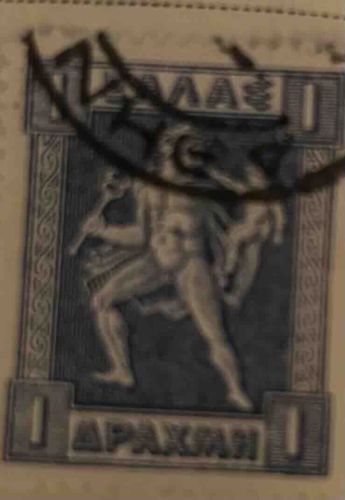
Greek 1 Drachma Stamp with Greek Mythology Depiction
This item is a postage stamp, likely of Greek origin, given the visible Greek lettering 'ΔΡΑΧΜΑ' (Drachma) at the bottom and 'ΕΛΛΑΣ' (Hellas/Greece) at the top. The stamp features a central illustration in a dark blue or gray tone against a lighter background, depicting two figures, presumably from Greek mythology or classical art. One figure appears to be a male, possibly muscular, in a dynamic pose, while the other is a smaller figure, possibly a child or a companion, positioned behind the larger figure. Both figures are depicted nude or semi-nude in a classical style. The background of the central image appears to be a solid dark color, possibly blue-black or deep grey. The border around the central image features an intricate, somewhat ornate pattern, suggestive of classical Greek or Roman architectural motifs, perhaps a meander or wave pattern. The denomination '1' is prominently displayed in boxes at the top right and bottom left corners, with 'ΔΡΑΧΜΑ' spelled out in Greek capital letters along the bottom edge. Another '1' is visible at the bottom right. The overall color scheme is monochromatic, primarily consisting of the dark blue/grey print on a lighter, possibly off-white or cream colored paper. The stamp appears to be perforated along all edges, although the perforations are not perfectly clear due to the image quality and cropping. A heavily blurred and dark cancellation mark diagonally crosses the upper center portion of the stamp, obscuring part of the 'ΕΛΛΑΣ' text and the heads of the figures. This cancellation mark suggests the stamp has been used. The paper shows some signs of age, consistent with an older philatelic item, though no significant tears or creases are immediately apparent beyond the cancellation. The resolution of the image makes it difficult to discern very fine details or specific manufacturing marks, but the printing quality appears reasonably high for its era, indicating professional production. The style period is likely late 19th to mid-20th century, based on the classical art depiction and the currency.
AI-Generated Appraisal Disclaimer
Estimated Value
$5 - $15
Basic Information
Category
Postage Stamp
Appraised On
December 25, 2025
Estimated Value
$5 - $15
Item Description
This item is a postage stamp, likely of Greek origin, given the visible Greek lettering 'ΔΡΑΧΜΑ' (Drachma) at the bottom and 'ΕΛΛΑΣ' (Hellas/Greece) at the top. The stamp features a central illustration in a dark blue or gray tone against a lighter background, depicting two figures, presumably from Greek mythology or classical art. One figure appears to be a male, possibly muscular, in a dynamic pose, while the other is a smaller figure, possibly a child or a companion, positioned behind the larger figure. Both figures are depicted nude or semi-nude in a classical style. The background of the central image appears to be a solid dark color, possibly blue-black or deep grey. The border around the central image features an intricate, somewhat ornate pattern, suggestive of classical Greek or Roman architectural motifs, perhaps a meander or wave pattern. The denomination '1' is prominently displayed in boxes at the top right and bottom left corners, with 'ΔΡΑΧΜΑ' spelled out in Greek capital letters along the bottom edge. Another '1' is visible at the bottom right. The overall color scheme is monochromatic, primarily consisting of the dark blue/grey print on a lighter, possibly off-white or cream colored paper. The stamp appears to be perforated along all edges, although the perforations are not perfectly clear due to the image quality and cropping. A heavily blurred and dark cancellation mark diagonally crosses the upper center portion of the stamp, obscuring part of the 'ΕΛΛΑΣ' text and the heads of the figures. This cancellation mark suggests the stamp has been used. The paper shows some signs of age, consistent with an older philatelic item, though no significant tears or creases are immediately apparent beyond the cancellation. The resolution of the image makes it difficult to discern very fine details or specific manufacturing marks, but the printing quality appears reasonably high for its era, indicating professional production. The style period is likely late 19th to mid-20th century, based on the classical art depiction and the currency.
Get Your Items Appraised
Instant estimates of your treasures with AI-powered instant appraisals